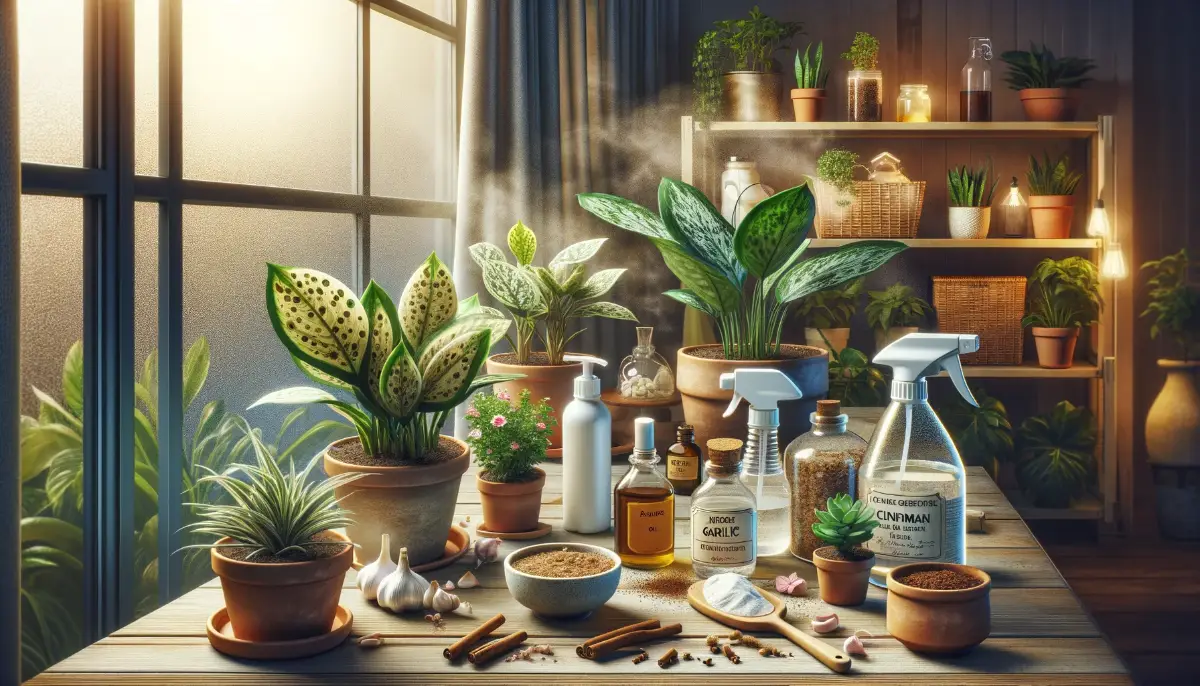Gray Mold, scientifically known as Botrytis cinerea, is a common fungal disease that poses a significant threat to a wide range of houseplants. This fungus thrives in warm, humid environments, attacking plants’ leaves, stems, and flowers, leading to decay and rot.
Understanding and identifying this blight early can be crucial to preventing widespread damage within your indoor garden.
Symptoms and Identification
Visual Signs: The primary indicator of Botrytis Blight is the appearance of fuzzy, gray, or brown growth on the affected parts of the plant. This mold can manifest as a thin film or a dense, cotton-like layer, which may produce a musty odor.
Common Symptoms: Infected plants may exhibit wilting, yellowing of leaves, soft or rotted stem or leaf tissue, and reduced growth. In severe cases, entire plants or plant parts may die off.
Specific Indications: Look for brown to gray circular spots on leaves, stems, and petals, flower buds that develop abnormally, or the presence of soft rot on corms and bulbs as telltale signs of Botrytis Blight.
Environmental Factors Contributing to Botrytis Blight
Humidity and Temperature: Gray mold proliferates in conditions of high humidity and moderate temperatures, often found in indoor gardens or greenhouses. Overcrowded plants with poor air circulation further facilitate its spread.
Moisture: Excess moisture, whether from overwatering or poor drainage, can exacerbate the risk of Botrytis Blight. The fungus requires water to germinate on plant surfaces, making moisture management a critical factor in prevention.
Injury and Weak Plants: Plants that are already stressed, damaged, or in decline are more susceptible to infection. The fungus often enters through wounds or breaks in the plant’s surface.
Recognizing the symptoms of Botrytis Blight and understanding the environmental conditions that favor its development are the first steps toward effective management and prevention. In the next section, we’ll explore natural remedies and prevention strategies to protect your houseplants from this pervasive threat.
Natural Remedies for Botrytis Blight
Soap Water Treatment: A simple yet effective method involves cleaning the infected areas with a mixture of water and a small amount of dish soap. This can help remove the fungus from the plant surfaces.
Prune or Stake Plants: Improve air circulation by pruning or staking plants, which helps reduce humidity around the plant foliage and lowers the potential for mold growth.
Onion Juice: Utilize the antifungal properties of onions by applying onion juice to affected areas. This can be prepared by blending onions and applying the strained juice with a spray bottle.
Neem Oil: Known for its antifungal capabilities, neem oil can be mixed with water and sprayed onto affected plants to combat gray mold.
Garlic Spray: Blend garlic bulbs with water, strain, and spray the mixture onto your plants. Garlic’s natural antifungal properties can help fight Botrytis blight and other fungal diseases.
Proper Plant Care: Keeping plants dry, spacing them properly to ensure good air circulation, and removing infected plants promptly are key steps to preventing gray mold.
Use of Soil Amendments: Enhancing soil with organic matter like compost, manure, or worm castings can foster beneficial bacteria and fungi, improving plant health and resistance to diseases.
Essential Oils: Sprays made from tea tree oil, lavender oil, or rosemary oil can have antifungal effects and help protect plants from fungal diseases.
Mulching: Applying mulch around plants can help retain soil moisture, suppress weeds, and prevent the splash of spores from the soil to plant parts.
Companion Planting: Growing plants together that benefit each other can naturally deter pests and diseases, including fungal infections.
Preventative Measures to Avoid Botrytis Blight
Maintain Proper Humidity and Ventilation: Ensure your indoor garden has good air circulation and appropriate humidity levels to discourage the growth of gray mold.
Soil Moisture Management: Overwatering can create conditions favorable to Botrytis. Allow the top inch of soil to dry out before watering again.
Regular Plant Inspection: Early detection is key to controlling Botrytis Blight. Inspect your plants regularly for any signs of infection and take immediate action if needed.
Avoid Overcrowding: Provide your plants with enough space to ensure adequate air circulation around them. This can significantly reduce the risk of Botrytis Blight.
Plant Care and Handling: Be gentle when handling, pruning, or transplanting your plants to avoid injuries where the fungus can enter.
Implementing these treatment strategies and preventative measures can help protect your houseplants from Gray Mold/Botrytis Blight, ensuring they remain healthy and vibrant. Always opt for natural remedies and good cultural practices first, resorting to chemical treatments only when necessary and as a last resort.
These methods not only address the immediate issue of gray mold but also contribute to the overall health and resilience of your garden. Always remember to act swiftly at the first sign of infection and to regularly monitor your plants for any signs of disease. Implementing these organic strategies can significantly reduce the incidence of gray mold in your garden.
FAQs about Gray Mold on Houseplants
What is gray mold and which houseplants are most susceptible?
Gray mold, also known as Botrytis cinerea, is a common fungal disease affecting many houseplants, particularly those in moist environments. Plants like begonias, peonies, and tomatoes are among those most susceptible.
How do I identify gray mold on my houseplants?
Gray mold appears as fuzzy, gray, or brown growth on leaves, stems, or flowers. Symptoms include wilting, yellowing of leaves, and a musty odor.
What conditions promote the growth of gray mold?
Warm, humid conditions with poor air circulation are ideal for the growth of gray mold. Overwatering and crowding plants can also contribute to its spread.
Can gray mold spread to other plants?
Yes, gray mold can easily spread through airborne spores or by coming into contact with infected plant material.
Are there natural remedies for treating gray mold?
Yes, treatments include using neem oil, garlic spray, onion juice, and improving air circulation through pruning and proper plant spacing.
How can I prevent gray mold from infecting my houseplants?
Preventive measures include avoiding overwatering, ensuring good air circulation, using soil amendments, and practicing proper watering techniques.
What should I do with plants infected by gray mold?
Remove and dispose of severely infected plants to prevent the spread of spores. For less severe infections, prune away infected parts and apply organic treatments.
Can gray mold affect the soil of my houseplants?
Gray mold primarily affects plant tissue but can live in the soil as sclerotia, which can harbor the fungus over the winter.
Is gray mold harmful to humans or pets?
While gray mold is not generally considered harmful to humans or pets, individuals with severe allergies or compromised immune systems should avoid handling infected plants.
Can gray mold be completely eradicated from my houseplants?
While it can be challenging to completely eradicate gray mold once it’s established, adopting a combination of treatment and preventive measures can significantly reduce its presence and prevent future outbreaks










